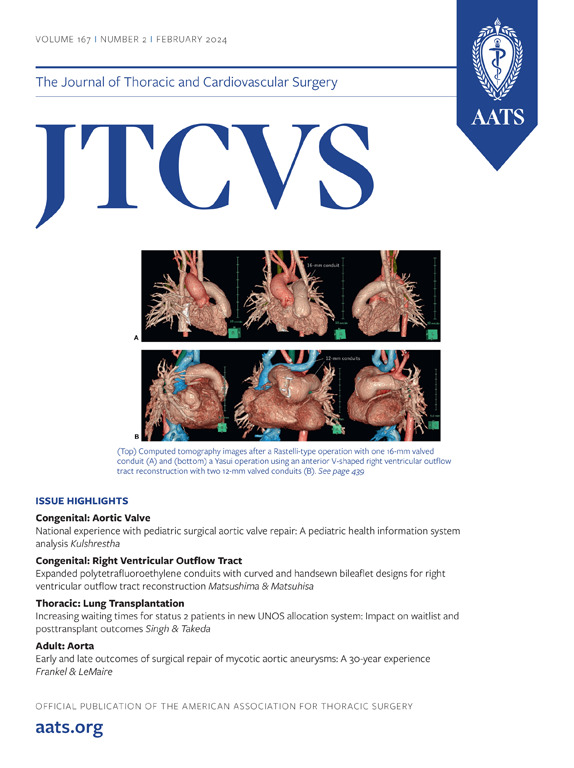The cone repair allows right ventricle rehabilitation with excellent tricuspid valve function following the Starnes procedure
IF 4.9
1区 医学
Q1 CARDIAC & CARDIOVASCULAR SYSTEMS
Journal of Thoracic and Cardiovascular Surgery
Pub Date : 2025-02-01
DOI:10.1016/j.jtcvs.2024.08.024
引用次数: 0
Abstract
Background
We present a case series of right ventricle (RV) rehabilitation after the Starnes procedure in patients with Ebstein anomaly (EA), applying the Cone repair of the tricuspid valve (TV) to achieve 2-ventricle or 1.5-ventricle physiology.
Methods
This is a retrospective database analysis from 2 institutions in North America. We included all consecutive cases of Cone repair after the Starnes procedure. The data are expressed as median and interquartile range (IQR).
Results
Eleven patients underwent RV rehabilitation between 2019 and 2023 after initial Starnes palliation at a median age of 27 months (IQR, 20.5 months). All patients were critically ill before their Starnes procedure, and 4 were on extracorporeal membrane oxygenation. Before the Cone repair, the median preoperative regurgitant velocity at the Starnes patch was 1.65 m/s (IQR, 1.3 m/s). During the Cone procedure, 9 patients required a concomitant pulmonary valve repair, of whom 3 needed a transannular monocusp patch. Four patients were successfully rerouted to a 2-ventricle repair, and 7 patients with a previous Glenn achieved 1.5-ventricle circulation. There were no cases of heart block and no deaths. Seven patients had trivial, 3 patients had mild, and 1 patient had moderate tricuspid regurgitation (TR) at a median follow-up of 11 months (IQR, 21.5 months). There was no significant TV stenosis; all patients had good functional status at the last follow-up despite severe RV dysfunction in 1 patient.
Conclusions
After the Starnes procedure, the Cone repair allowed RV rehabilitation, resulting in trivial or mild TR at a midterm follow-up. The Starnes procedure is a reproducible technique that no longer commits patients to lifetime single-ventricle physiology.
锥形修补术允许右心室在斯塔内斯手术后恢复良好的三尖瓣功能。
目的:方法:这是一项回顾性数据库分析,来自北美两家医院:这是一项来自北美两家机构的回顾性数据库分析。方法:这是一项来自北美两家机构的回顾性数据库分析,我们纳入了所有在 Starnes 手术后进行 Cone 修复的连续病例。数据以中位数和四分位数间距(IQR)表示:结果:11名患者在最初的Starnes姑息术后于2019年至2023年间接受了RV康复治疗,中位年龄为27个月(IQR为20.5)。所有患者在接受斯塔内斯手术前均病情危重,其中四人接受了体外膜氧合。在进行Cone修复术前,Starnes修补处的术前反流速度中位数为1.65 m/s(IQR为1.3)。在 Cone 手术过程中,有九名患者需要同时进行 PV 修复,其中三名患者需要进行跨瓣单焦点修补。四名患者成功转为双心室修复,七名曾接受过 Glenn 手术的患者实现了 1.5 心室循环。没有发生心脏传导阻滞,也没有死亡病例。七名患者在中位 11 个月(IQR 21.5)的随访中出现了轻微的三尖瓣反流,其中三名为轻度,一名为中度。所有患者在最后一次随访时均功能状况良好,尽管其中一名患者存在严重的 RV 功能障碍:结论:Starnes 手术后,Cone 修复术可使 RV 恢复正常,因此在中期随访时,TV 反流的程度轻微。斯塔内斯手术是一种可重复的技术,不再使患者终身处于单心室生理状态。
本文章由计算机程序翻译,如有差异,请以英文原文为准。
求助全文
约1分钟内获得全文
求助全文
来源期刊
CiteScore
11.20
自引率
10.00%
发文量
1079
审稿时长
68 days
期刊介绍:
The Journal of Thoracic and Cardiovascular Surgery presents original, peer-reviewed articles on diseases of the heart, great vessels, lungs and thorax with emphasis on surgical interventions. An official publication of The American Association for Thoracic Surgery and The Western Thoracic Surgical Association, the Journal focuses on techniques and developments in acquired cardiac surgery, congenital cardiac repair, thoracic procedures, heart and lung transplantation, mechanical circulatory support and other procedures.

 求助内容:
求助内容: 应助结果提醒方式:
应助结果提醒方式:


